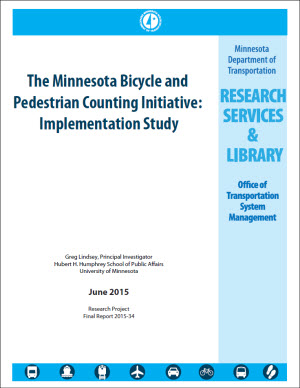 Researchers at the Humphrey School of Public Affairs at the University of Minnesota published The Minnesota Bicycle and Pedestrian Counting Initiative: Implementation Study. The non-motorized counting Initiative was launched in 2011 as a collaborative, statewide effort to encourage and support non-motorized traffic monitoring by local, regional, and state governments and nonprofit organizations. The Minnesota Department of Transportation (MnDOT) has funded three projects to support the Initiative:
Researchers at the Humphrey School of Public Affairs at the University of Minnesota published The Minnesota Bicycle and Pedestrian Counting Initiative: Implementation Study. The non-motorized counting Initiative was launched in 2011 as a collaborative, statewide effort to encourage and support non-motorized traffic monitoring by local, regional, and state governments and nonprofit organizations. The Minnesota Department of Transportation (MnDOT) has funded three projects to support the Initiative:
- Methodologies for Counting Bicyclists and Pedestrians in Minnesota (2011-13)
- Implementing Bicycle and Pedestrian Traffic Counts and Data Collection (2013-15)
- Institutionalizing the Use of State and Local Pedestrian and Bicycle Traffic Counts (2014-16)
The implementation study summarizes the results of the second project, which had as a general goal the demonstration of the feasibility of using automated sensors to collect bicycle and pedestrian traffic data in Minnesota. The objectives were to install and validate permanent automated sensors, use portable sensors for short duration counts, develop models for extrapolating counts, and integrate continuous counts into MnDOT traffic monitoring databases. Commercially available sensors – including inductive loops, integrated inductive loops and passive infrared, pneumatic tubes, and radio beams – were installed both as permanent monitor sites and used for short-duration counts at a variety of locations in cities, suburbs, and small towns across Minnesota.
All sensors tested in the study produced reasonably accurate measures of bicycle and pedestrian traffic. Most sensors undercounted because of their inability to distinguish and count bicyclists or pedestrians passing simultaneously. Accuracy varied with technology, care and configuration of deployment, maintenance, and analytic methods. Bicycle and pedestrian traffic volumes varied greatly across locations, with highest volumes being on multiuse trails in urban areas.
FHWA protocols were used to estimate annual average daily traffic and miles traveled on an 80-mile multiuse trail network in Minneapolis. Project findings are incorporated in a new MnDOT guidance document, "DRAFT Bicycle and Pedestrian Data Collection Manual," used in statewide training workshops. Data management is a major part of and a major challenge for implementing bicycle and pedestrian traffic monitoring. Many years will likely be required to institutionalize bicycle and pedestrian traffic successfully.